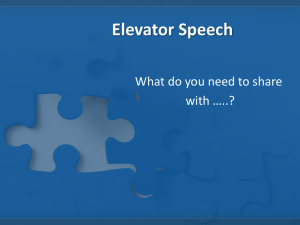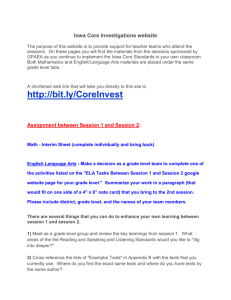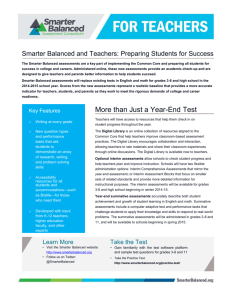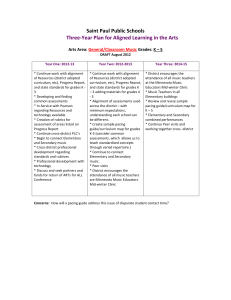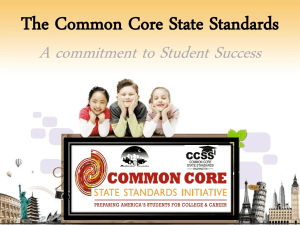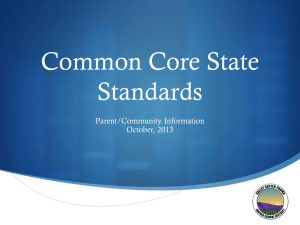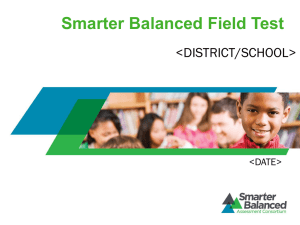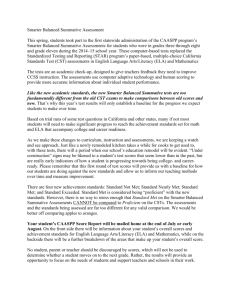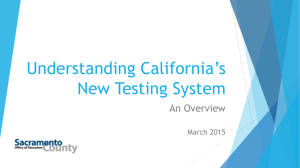Writing on the Smarter Balanced assessments will be scored in
advertisement
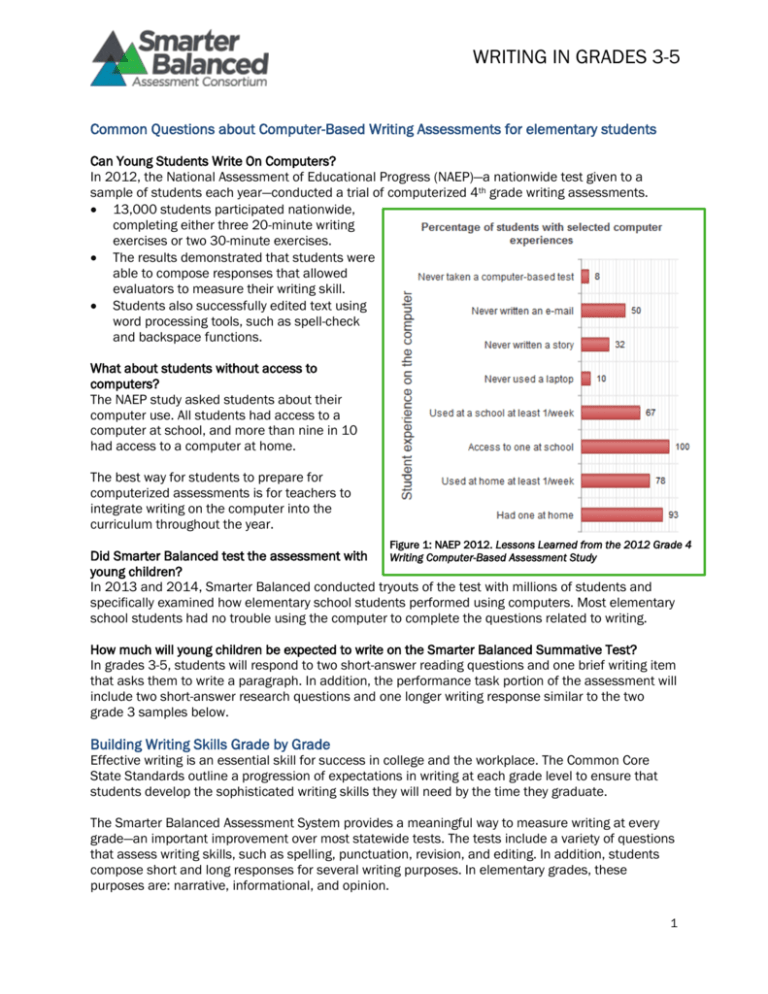
WRITING IN GRADES 3-5 Common Questions about Computer-Based Writing Assessments for elementary students Can Young Students Write On Computers? In 2012, the National Assessment of Educational Progress (NAEP)—a nationwide test given to a sample of students each year—conducted a trial of computerized 4th grade writing assessments. 13,000 students participated nationwide, completing either three 20-minute writing exercises or two 30-minute exercises. The results demonstrated that students were able to compose responses that allowed evaluators to measure their writing skill. Students also successfully edited text using word processing tools, such as spell-check and backspace functions. What about students without access to computers? The NAEP study asked students about their computer use. All students had access to a computer at school, and more than nine in 10 had access to a computer at home. The best way for students to prepare for computerized assessments is for teachers to integrate writing on the computer into the curriculum throughout the year. Figure 1: NAEP 2012. Lessons Learned from the 2012 Grade 4 Did Smarter Balanced test the assessment with Writing Computer-Based Assessment Study young children? In 2013 and 2014, Smarter Balanced conducted tryouts of the test with millions of students and specifically examined how elementary school students performed using computers. Most elementary school students had no trouble using the computer to complete the questions related to writing. How much will young children be expected to write on the Smarter Balanced Summative Test? In grades 3-5, students will respond to two short-answer reading questions and one brief writing item that asks them to write a paragraph. In addition, the performance task portion of the assessment will include two short-answer research questions and one longer writing response similar to the two grade 3 samples below. Building Writing Skills Grade by Grade Effective writing is an essential skill for success in college and the workplace. The Common Core State Standards outline a progression of expectations in writing at each grade level to ensure that students develop the sophisticated writing skills they will need by the time they graduate. The Smarter Balanced Assessment System provides a meaningful way to measure writing at every grade—an important improvement over most statewide tests. The tests include a variety of questions that assess writing skills, such as spelling, punctuation, revision, and editing. In addition, students compose short and long responses for several writing purposes. In elementary grades, these purposes are: narrative, informational, and opinion. 1 WRITING IN GRADES 3-5 The Smarter Balanced assessments are administered online. Students type their responses on a keyboard and have access to editing tools that allow them to revise their work. Because the test is untimed, students can work at their own pace. The shift to online assessments brings many benefits, but as with any test, it is critical that young students also have the support they need to succeed. To help students prepare, schools are incorporating computers into classroom instruction in the elementary grades to allow students to gain familiarity with technology and develop keyboarding skills. Smarter Balanced has also made Practice and Training Tests available online to help students prepare for the new assessments. Appropriate Expectations for Writing The Common Core emphasizes the importance of developing writing skills in the elementary grades. In addition, the standards call for students to use computers to compose and publish writing—a minimum of two pages in a single sitting by 5th grade. Teachers are focusing on writing skills throughout the year so that students can be prepared for the demands of middle and high school. Figure 2: Grade-by-Grade Progression of Common Core State Standards for the Production and Distribution of Writing Grade 5: Grade 4: Grade 3: •With guidance and support from adults, produce writing in which the development and organization are appropriate to task and purpose. •With guidance and support from peers and adults, develop and strengthen writing as needed by planning, revising, and editing. •With guidance and support from adults, use technology to produce and publish writing (using keyboarding skills) as well as to interact and collaborate with others. (CCSS.ELA-Literacy.W.3.4-3.6) •Produce clear and coherent writing in which the development and organization are appropriate to task, purpose, and audience. •With guidance and support from peers and adults, develop and strengthen writing as needed by planning, revising, and editing. •With some guidance and support from adults, use technology, including the Internet, to produce and publish writing as well as to interact and collaborate with others; demonstrate sufficient command of keyboarding skills to type a minimum of one page in a single sitting. (CCSS.ELALiteracy.W.4.4-4.6) •Produce clear and coherent writing in which the development and organization are appropriate to task, purpose, and audience. •With guidance and support from peers and adults, develop and strengthen writing as needed by planning, revising, editing, rewriting, or trying a new approach. •With some guidance and support from adults, use technology, including the Internet, to produce and publish writing as well as to interact and collaborate with others; demonstrate sufficient command of keyboarding skills to type a minimum of two pages in a single sitting. (CCSS.ELA-Literacy.W.5.4-5.6) Helping Students Prepare Online Practice and Training Tests allow students to gain familiarity with the types of questions and the test interface. Students can practice navigating test questions, responding to writing prompts, and using features like spell check. The tests are designed with the same features included in the year-end assessment, including all embedded universal tools, designated supports, and 2 WRITING IN GRADES 3-5 accommodations. These tests are available online at any time: http://www.smarterbalanced.org/practice-test/. Scoring Student Writing on the Performance Task Writing on the Smarter Balanced assessments will be scored in much the same way as traditional paper-and-pencil assessments. Trained scorers read every response and assign a score in each of three categories: 1. Organization/purpose of the writing; 2. Evidence/elaboration (use of evidence, details and development); and 3. Adherence to correct conventions (spelling, capitalization, punctuation, etc.). Readers evaluate student responses for the quality of writing—not the quantity. Students may demonstrate their skills in a relatively short response. Figure 3 shows a 3rd grade response that received three of four potential points for organization. Figure 3: Grade 3, Narrative – Scored Only for Organization and Purpose, Sample 3-Point Baseline Anchor Response 3 WRITING IN GRADES 3-5 When it comes to writing conventions—such as spelling, grammar, and punctuation—young students are not expected to produce writing that is completely error free. For example, figure 4 shows a 3rd grade response that received two out of two potential points for conventions, despite a few errors. Figure 4: Grade 3, Conventions, Sample 2-Point Baseline Anchor Response 4
